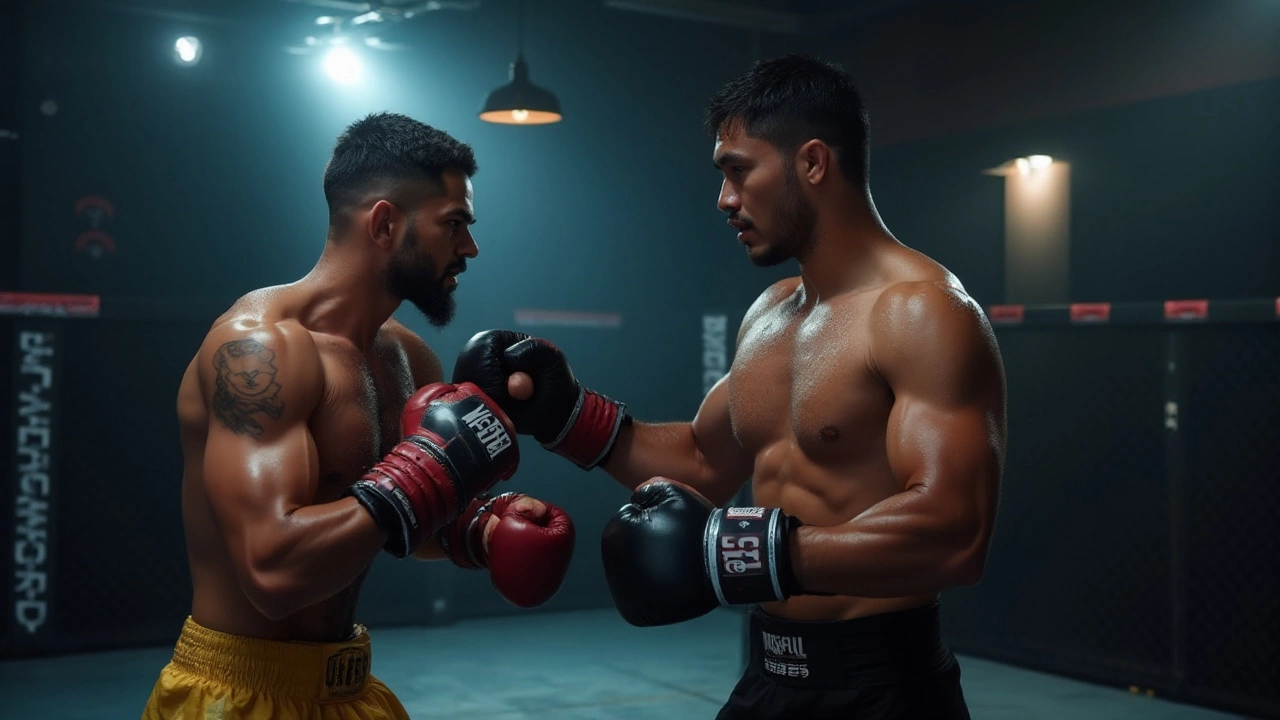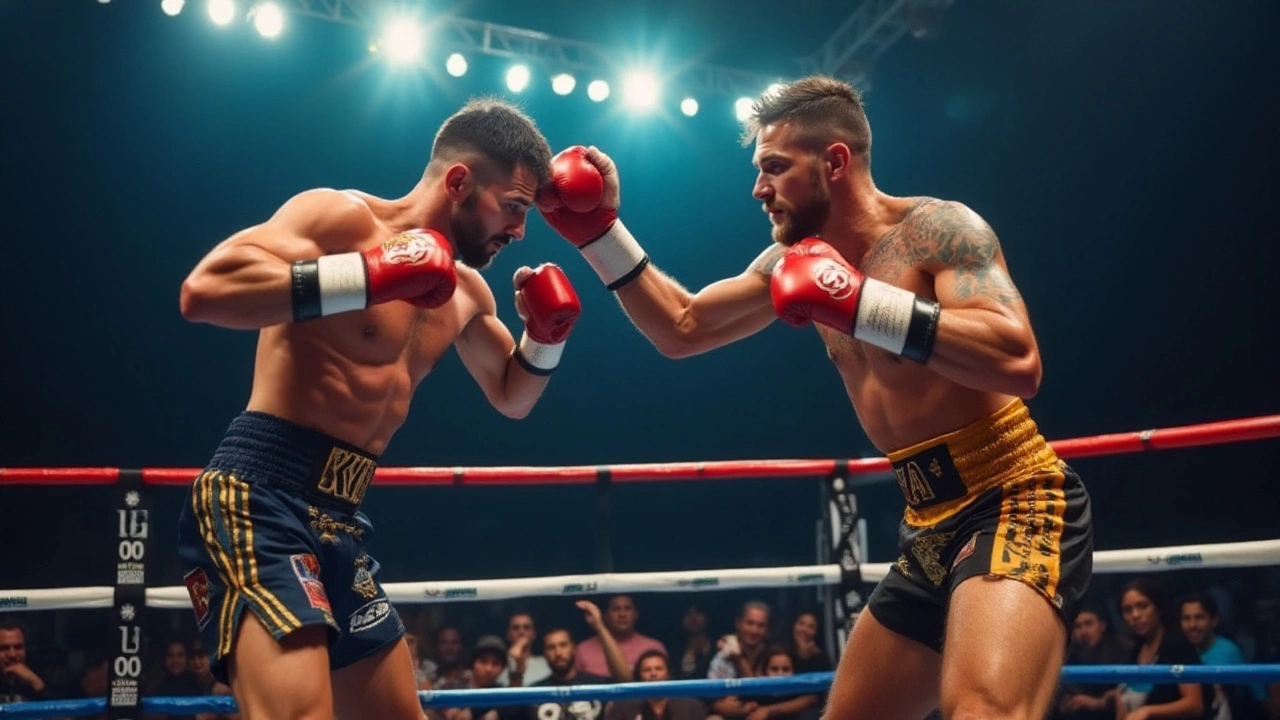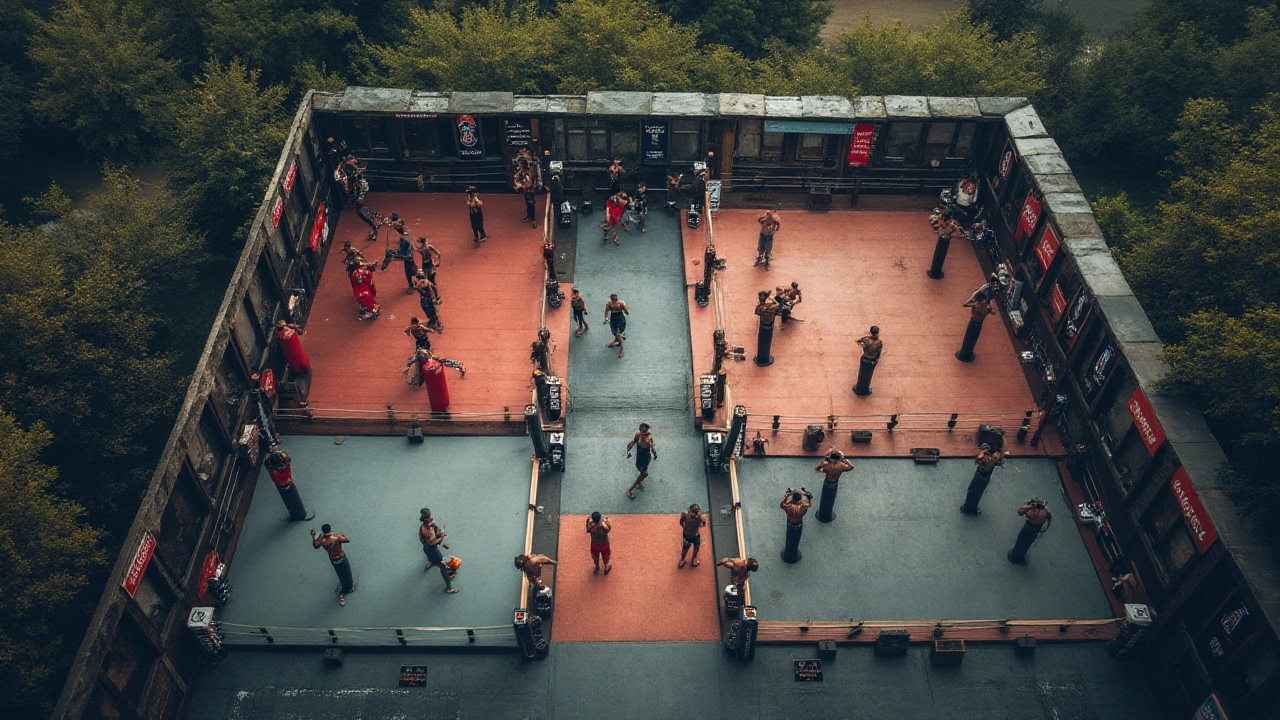Boxers Transitioning to MMA: Challenges and Opportunities

Boxing and mixed martial arts (MMA) may appear similar at first glance, both involving combat and striking, yet they encompass different worlds of competitive sports. As the popularity of MMA continues to rise, many boxers are intrigued by the idea of stepping into the octagon. This transition, while enticing, is not without its share of challenges and transformations.
For a boxer accustomed to a ring with strict rules on striking, moving into a sport that combines multiple fighting disciplines can be overwhelming. Yet, it's precisely this blend of techniques that makes MMA so alluring to athletes searching for new ways to demonstrate their prowess. While mastering kicks, grappling, and ground fighting is vital, boxers can capitalize on their already finely tuned striking skills.
Venturing from the ring to the cage is a bold decision, often sparked by the aspiration to grow beyond the confines of traditional boxing. Those who have successfully made this shift often inspire others, proving that with the right mindset and training regime, anything is possible. Exploring the experiences and paths of past trailblazers in this journey can offer valuable insights for boxers willing to step outside their comfort zones.
- The Appeal of MMA for Boxers
- Key Differences: Boxing and MMA
- Notable Boxers Who Transitioned
- Training for MMA: Adapting Skills
- Tips for a Successful Transition
The Appeal of MMA for Boxers
Arguably more dynamic in its approach than traditional boxing, mixed martial arts (MMA) offers an expansive canvas for athletes hungry for new challenges and opportunities. For boxers, stepping into the world of MMA can be incredibly tempting. The octagon is not just another venue but a whole new realm of combat possibilities. Unlike boxing, which is solely focused on the art of striking with fists, MMA employs a multitude of techniques that include grappling, submissions, and a wide variety of striking styles. This complexity is often seen as an alluring aspect for boxers who have mastered their trade in the ring and seek to broaden their skill set.
One major appeal of making such a transition is the chance to engage with a wider fan base. With its explosive growth over the past decade, MMA has become a global phenomenon, attracting fans who enjoy the unpredictability and drama of a sport that can see a fight won in various ways, be it a knockout, a submission, or a judge's decision. This diversification in audience is appealing for boxers who wish to enhance their marketability and career longevity. By crossing over into MMA, boxers can not only continue to develop professionally but also maintain and grow their presence in the sports community.
Boxers considering this path often point to the lucrative opportunities and fame that MMA fighters enjoy. The combination of different martial arts techniques allows fighters to continually challenge themselves and improve upon their craft. As a result, the MMA world has seen a steady influx of boxers willing to test their mettle, each bringing their unique take on striking and strategy. Boxers have a natural advantage in that department, given their specialized training in precision, timing, and power in punches, which can provide them a head start in the striking battles within the cage.
In reflecting on the thrills of MMA, acclaimed fight promoter Dana White once noted,
"The versatility and adaptability of MMA are what make it exciting. It demands fighters to be complete and well-rounded, and that is a compelling aspect for any athlete looking to challenge their limits."This sentiment resonates clearly with boxers who have dominated the squared circle and find themselves yearning for a fresh, multifaceted challenge. The rigorous training regimen, the required adaptability, and the diverse range of techniques contribute to an enticing new frontier for experienced boxers.
MMA also offers boxers the chance to fight more frequently. The nature of boxing often ties fighters to promotional contracts and lengthy periods between events. In contrast, the MMA structure potentially allows for more flexibility and fighting opportunities, especially if a boxer is willing to adapt to the varying disciplines involved. This not only helps in avoiding lengthy idle periods but also keeps the fighters in peak physical condition more consistently, making them better prepared for combat both physically and mentally.
Key Differences: Boxing and MMA
Boxing and mixed martial arts (MMA) might both be combat sports, but they differ significantly in their rules, techniques, and the very nature of their athletic competition. One of the most notable distinctions lies in the range of combat techniques embraced by each sport. Boxers rely solely on their punching ability, crafting art and strategy out of a limited set of tools. On the other hand, MMA fighters engage in a multifaceted battle that combines striking with grappling, employing an arsenal that includes kicks, elbows, knees, and submissions. This expansive array of techniques demands a breadth of strategy and training beyond what boxing encompasses.
Furthermore, the fighting environment itself presents stark contrasts. A boxing match takes place in a square ring with rope boundaries, offering a moderately predictable terrain. MMA fights occur in an octagonal cage, often called "the cage," which introduces a new dynamic with its ability to be used both offensively and defensively. The cage allows fighters to press their opponents against it, leveraging it for control or escape, an element absent in boxing.MMA also differentiates itself with its approach to scoring and duration of bouts. In boxing, matches are prolonged over a series of rounds, encouraging a strategic pace and endurance testing. MMA matches are typically shorter, with a fast-paced, more aggressive style rewarded more highly. The scoring, too, incorporates a broader evaluation of techniques, looking beyond punches to assess takedowns, control poses, and strikes through multiple phases.
In addition, equipment used by fighters highlights the sports’ differences. Boxers wear heavily padded gloves, designed primarily to protect the hands and soften blows, while MMA fighters use lighter, fingerless gloves allowing for grappling. The lighter gloves in MMA mean that punches can be more damaging, but also open up the possibility for potentially immobilizing grips and holds. Perhaps most critical is how these differences shape the fighters themselves. A boxer may be conditioned for prolonged upper-body endurance, while an MMA athlete must balance strength with agility, endurance, and resilience across all body parts.
An interesting perspective comes from legendary boxing champion Mike Tyson, who once remarked on the versatility required in MMA:
"It's interesting how complex the fighting world is... Those MMA guys, they have to learn so much. It's more than just a punch. They are masters of everything."Ultimately, this rich complexity is what draws some boxers into the world of MMA. The blend of varied fighting styles not only challenges their skills but offers an opportunity to reshape themselves as fighters, integrating techniques from wrestling, Brazilian Jiu-Jitsu, Muay Thai, and more. This transition is not merely a switch of sport; it represents a deep evolution in their fighting philosophy and practice.
| Feature | Boxing | MMA |
|---|---|---|
| Combat Techniques | Punching | Punching, Kicking, Grappling |
| Competition Area | Square Ring | Octagonal Cage |
| Scoring & Match Pace | Longer Rounds | Shorter, Aggressive |
| Gloves | Heavily Padded | Light, Fingerless |
| Skill Set | Upper-Body Focus | Full-Body Skills |

Notable Boxers Who Transitioned
When boxers decide to move into the world of MMA, they are often met with skepticism from both fans and sports analysts. Despite the difference in disciplines, there have been some remarkable fighters who have made the leap and managed to leave a mark in both arenas. One of the most famous examples is Holly Holm. Known as ‘The Preacher’s Daughter,’ Holm had a successful boxing career with an impressive record of 33 wins, 2 losses, and 3 draws before transitioning to MMA.
Holm took the MMA world by storm when she managed to knock out Ronda Rousey, a dominant champion at the time, in a bout that shocked the world. She showcased not just her boxing prowess but her adaptability and strategic planning against a seemingly invincible opponent. This moment was a significant turning point not only for Holm but for the perception of boxers in MMA, proving that boxers can pose serious challenges in the octagon with the right preparation.
"It's not just about the hands; it's about adaptation and embracing the entire range of combat techniques," Holm commented post-victory, reflecting on her transition from boxing to MMA.
Another well-known name in this crossover is James Toney. Toney, celebrated in the boxing world for his middleweight and heavyweight success, took his chance in the Ultimate Fighting Championship (UFC) back in 2010. Though his debut bout against Randy Couture ended in defeat, Toney's audacious move highlighted how boxers perceive opportunities in MMA, despite the risks. His attempt illustrated the challenges boxers face, like the need for comprehensive ground-game skills, which are critical in MMA.
An interesting case is that of Conor McGregor, who ventured in the opposite direction. As an established MMA fighter known for his striking capabilities, he took on the much-hyped boxing match against Floyd Mayweather. While he isn't a traditional boxer transitioning to MMA, his crossover underscores the bridge between these combat sports, emphasizing skill exchange potential.
Some fighters think about making the switch primarily because of the limitations within boxing matches, craving the diversity of combat MMA offers. Shannon Briggs, a former heavyweight boxing champion, often talks about wanting a piece of the action inside the octagon, igniting excitement over the continuous merging of worlds.
These stories remind us of the inherent risks and rewards when athletes switch from one sport to another. They must adapt to new techniques while often competing against younger, more experienced fighters in the new discipline. Their journeys are testament to their ambition and passion, inspiring others who stand on the edge of trying to broaden their combat arenas. Such transitions, though not always seamless, continue to intrigue fans worldwide, fueling the narrative that boxers can not only survive but thrive in MMA.
Training for MMA: Adapting Skills
Transitioning from the ring of boxing to the versatile world of MMA involves a thorough overhaul of an athlete's training regimen. In boxing, the focus predominantly lies on mastering punches, footwork, and dodges in a standing position. However, once a boxer chooses to enter mixed martial arts, the game changes significantly, urging them to build a diverse skill set that includes grappling, kicking, and wrestling. This requires a fundamental shift in training focus, and boxers must adapt by embracing the multifaceted nature of combat sports. What might have been their strength in boxing – the art of striking – needs to be complemented with comprehensive defensive strategies against takedowns and getting accustomed to fighting on the ground – a stark contrast to their usual upright battles.
One pivotal aspect of training is to develop a proficiency in grappling, which stands as a cornerstone of MMA. Many boxers find this particularly challenging, as grappling demands a level of comfort with techniques such as submissions and clinching, which are alien in the ring. A boxer aspiring to succeed in the cage might begin working intensively with a Brazilian Jiu-Jitsu coach, building their strength and mobility for ground combat. This transition parallels the journey of fighters like James Toney, who famously made the shift to MMA after a celebrated boxing career. Though Toney faced challenges in the octagon, his journey underscores the need for a holistic approach in training. "The cage doesn't play favorites. Every weakness is exposed," a sentiment echoed by Randy Couture, an MMA legend known for his savvy strategies.
In addition to grappling, learning to incorporate kicks effectively is essential. Boxers are accustomed to using their fists as their primary weapons, but in MMA, legs become crucial instruments of both attack and defense. Training regimes for transitioning boxers should incorporate Muay Thai or kickboxing sessions to learn about kicking techniques, the importance of shin conditioning, and balance when delivering high, mid, or low kicks. The concept of using every limb as a weapon is an exhilarating yet demanding challenge, propelling boxers to think and fight outside of their comfort zone.
Conditioning also takes a diversified approach in MMA. Given the lengthy nature of MMA fights, which can push up to five rounds lasting five minutes each, endurance becomes critical. Building stamina not only occurs through rigorous cardio routines but also through long, grueling sparring sessions simulating live competition. Developing not just the body but also the mind is equally vital. The mental shift a boxer needs, from standing and striking to being ready for a ground game, is profound. They must learn to adjust tempo quickly and make calculated decisions in unfamiliar positions, an art that many seasoned MMA fighters feel sets the greats apart from the goods.
A strategic blend of cross-training disciplines – from weightlifting to enhance strength and explosiveness to practicing yoga for flexibility – can complement the boxer’s core regime. Having an all-encompassing fitness strategy helps maximize physical capacities while minimizing the risk of injuries. Utilizing varied workouts helps boxers transition seamlessly and maintain competitive longevity in the highly demanding arena of mixed martial arts.
For boxers eager to make the leap into MMA, a meticulously structured training plan that encompasses these new dimensions is crucial to foster success. With dedication and the right resources, transitioning fighters can leverage their established striking mastery to navigate the complexities of MMA, enriching their combat sports career while enthralling fans across both the ring and the cage.

Tips for a Successful Transition
Transitioning from the artful realm of boxing to the dynamic landscape of MMA is a journey that challenges both the body and the mind. For a boxer, this progression demands the mastery of new skills as well as a fresh tactical mindset. Given the intricate nature of combat sports, the initial step is often to understand and appreciate the differences. Embracing the multi-disciplinary nature of MMA is crucial. Unlike boxing, where the focus is solely on striking with fists, MMA encompasses a broad range of techniques, including kicking, grappling, and ground fighting. This means aspiring mixed martial artists must train across various disciplines to develop a well-rounded skill set capable of withstanding the diverse challenges an MMA match presents.
Developing a training plan that emphasizes all aspects of MMA is critical. Boxers should incorporate Brazilian Jiu-Jitsu, wrestling, and Muay Thai into their regimen, integrating these alongside their existing striking skills. It's beneficial to work with coaches who specialize in MMA rather than boxing, as they'll offer insights specific to the sport’s unique demands. A sound plan would include not only strengthening new skills but also evolving the mental strategies required for cage fighting, such as defending against takedowns and maintaining effective ground control. It's a continuous learning curve, but determination and dedication can pave the way for success.
The transition is not solely about physical adaptation; mental resilience plays a significant role. Fighters must cultivate a mindset open to learning and adapting new techniques. Acknowledging one’s limitations in the beginning and progressively improving them is vital. Training with experienced MMA fighters can help speed up this process. As UFC champion Conor McGregor once noted,
"There's no talent here, this is hard work. This is an obsession."Understanding the versatile nature of MMA requires patience, and accepting this early on can make a significant difference.
Nutrition and recovery are equally essential aspects of a successful transition. While both boxing and MMA require athletes to be in peak physical condition, the demands of MMA can be more exhaustive, given the sport’s longer durations and varied activities. A nutritionist specializing in MMA can tailor meal plans to support rigorous training schedules. Meanwhile, incorporating ample rest and recovery stages in the training regimen ensures the body and mind remain in optimal condition for learning and adaptation. Hydration, maintaining muscle mass, and energy balance are critical focal points.
Final tips for transitioning boxers include immersing themselves in the MMA community. Watching fights, attending events, and analyzing the intricacies of different fighting styles offer invaluable insights. Engaging with enthusiasts and fighters can provide encouragement and a deeper understanding of what being an MMA fighter entails. Whether training in a local gym or at a major fight camp, the environment and community play a pivotal role in shaping a fighter’s experience and success story, as these elements contribute extensively to growth and adaptation in the sport of MMA.
